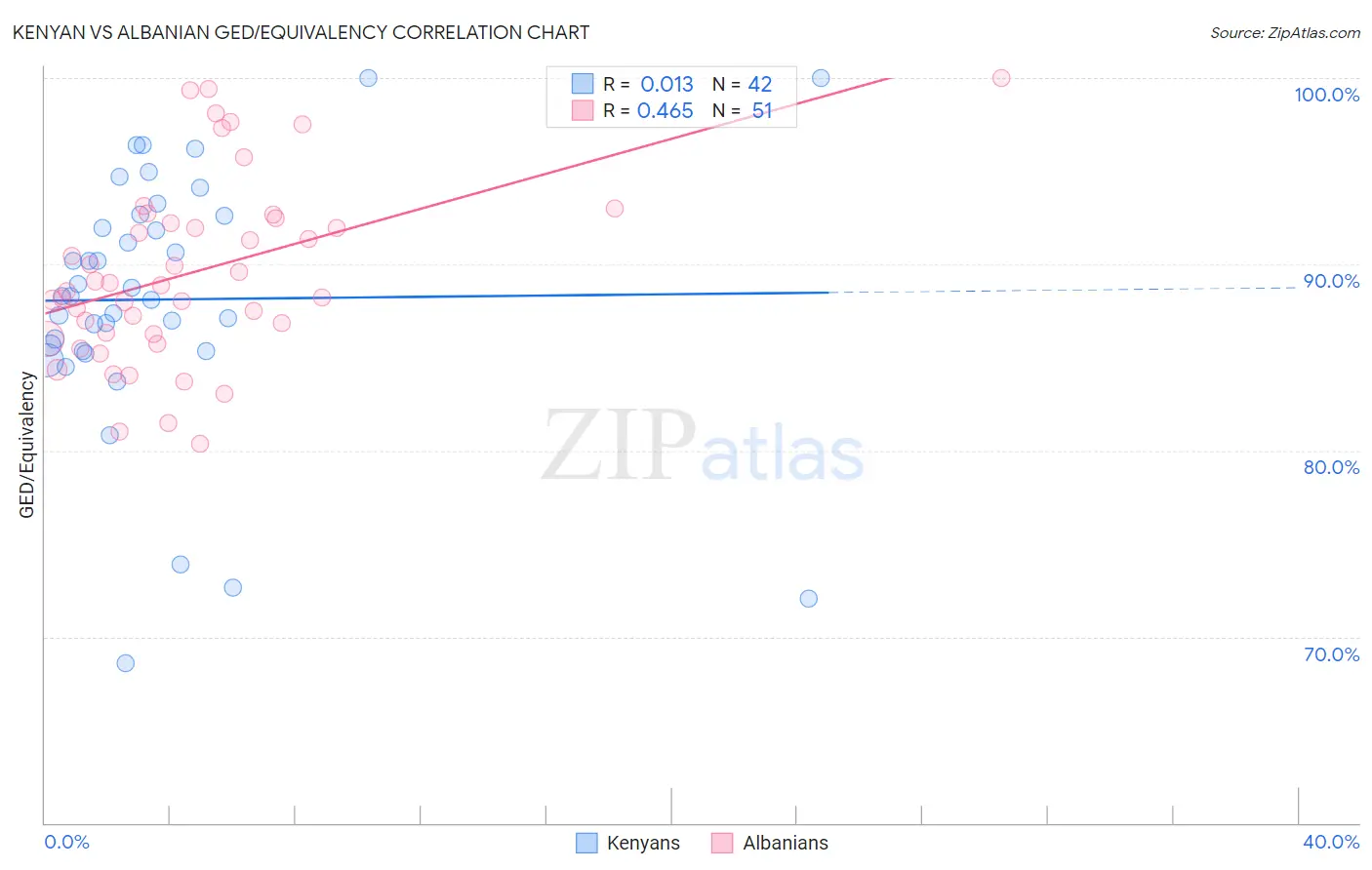Kenyan vs Albanian GED/Equivalency
COMPARE
Kenyan
Albanian
GED/Equivalency
GED/Equivalency Comparison
Kenyans
Albanians
86.3%
GED/EQUIVALENCY
76.6/ 100
METRIC RATING
153rd/ 347
METRIC RANK
86.6%
GED/EQUIVALENCY
87.7/ 100
METRIC RATING
134th/ 347
METRIC RANK
Kenyan vs Albanian GED/Equivalency Correlation Chart
The statistical analysis conducted on geographies consisting of 168,244,481 people shows no correlation between the proportion of Kenyans and percentage of population with at least ged/equivalency education in the United States with a correlation coefficient (R) of 0.013 and weighted average of 86.3%. Similarly, the statistical analysis conducted on geographies consisting of 193,265,279 people shows a moderate positive correlation between the proportion of Albanians and percentage of population with at least ged/equivalency education in the United States with a correlation coefficient (R) of 0.465 and weighted average of 86.6%, a difference of 0.40%.

GED/Equivalency Correlation Summary
| Measurement | Kenyan | Albanian |
| Minimum | 68.6% | 80.3% |
| Maximum | 100.0% | 100.0% |
| Range | 31.4% | 19.7% |
| Mean | 88.1% | 89.6% |
| Median | 88.3% | 88.9% |
| Interquartile 25% (IQ1) | 85.3% | 86.3% |
| Interquartile 75% (IQ3) | 92.6% | 92.5% |
| Interquartile Range (IQR) | 7.3% | 6.2% |
| Standard Deviation (Sample) | 6.9% | 4.9% |
| Standard Deviation (Population) | 6.8% | 4.8% |
Demographics Similar to Kenyans and Albanians by GED/Equivalency
In terms of ged/equivalency, the demographic groups most similar to Kenyans are Brazilian (86.3%, a difference of 0.020%), Immigrants from Bosnia and Herzegovina (86.3%, a difference of 0.040%), Immigrants from Western Asia (86.3%, a difference of 0.070%), Immigrants from Northern Africa (86.3%, a difference of 0.080%), and Immigrants from Poland (86.3%, a difference of 0.080%). Similarly, the demographic groups most similar to Albanians are Immigrants from Asia (86.6%, a difference of 0.010%), Tsimshian (86.6%, a difference of 0.030%), Chilean (86.6%, a difference of 0.040%), Arab (86.6%, a difference of 0.040%), and Immigrants from Argentina (86.6%, a difference of 0.050%).
| Demographics | Rating | Rank | GED/Equivalency |
| Tsimshian | 88.3 /100 | #133 | Excellent 86.6% |
| Albanians | 87.7 /100 | #134 | Excellent 86.6% |
| Immigrants | Asia | 87.4 /100 | #135 | Excellent 86.6% |
| Chileans | 86.9 /100 | #136 | Excellent 86.6% |
| Arabs | 86.7 /100 | #137 | Excellent 86.6% |
| Immigrants | Argentina | 86.5 /100 | #138 | Excellent 86.6% |
| Immigrants | Malaysia | 85.0 /100 | #139 | Excellent 86.5% |
| Paraguayans | 84.1 /100 | #140 | Excellent 86.5% |
| Laotians | 83.2 /100 | #141 | Excellent 86.5% |
| Immigrants | Indonesia | 82.4 /100 | #142 | Excellent 86.4% |
| Immigrants | Pakistan | 82.4 /100 | #143 | Excellent 86.4% |
| Bolivians | 82.1 /100 | #144 | Excellent 86.4% |
| Pakistanis | 80.4 /100 | #145 | Excellent 86.4% |
| Basques | 79.5 /100 | #146 | Good 86.4% |
| Immigrants | Northern Africa | 79.3 /100 | #147 | Good 86.3% |
| Immigrants | Poland | 79.3 /100 | #148 | Good 86.3% |
| Menominee | 79.3 /100 | #149 | Good 86.3% |
| Immigrants | Western Asia | 78.8 /100 | #150 | Good 86.3% |
| Immigrants | Bosnia and Herzegovina | 77.9 /100 | #151 | Good 86.3% |
| Brazilians | 77.2 /100 | #152 | Good 86.3% |
| Kenyans | 76.6 /100 | #153 | Good 86.3% |